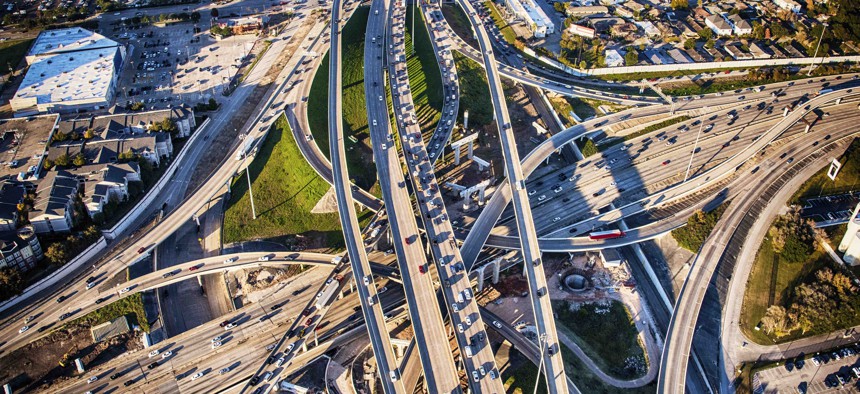Why It's So Hard to Convince the Public on Transportation Projects

A highway interchange in Houston Art Wager via Getty Images
Drivers and engineers often hold very different attitudes on transportation that directly contradict those of transportation planners, new research shows.
Engineers and the general public often hold attitudes on transportation topics that directly contradict core tenets of the transportation planning profession, and those differences are especially stark when it comes to reducing the use of automobiles, a new study found.
The contrasts start with the purpose of transportation policy itself. The study, conducted by several planning professors and published in the Journal of Planning Education and Research, found 83% of transportation planning students supported the goal of reducing driving, compared to only 52% of engineering students. The public was even more skeptical. Just 31% of respondents agreed with that goal.
Another major division concerned the idea of “induced demand.” The planning profession has largely coalesced against the approach of trying to widen highways and other roads in an effort to reduce congestion on them. Bigger roads don’t solve congestion, because more people drive when the roadways have more capacity.
While the idea has been widely discussed in the planning world since the 1990s, it has been more controversial outside of the profession. Elon Musk, for example, has called it “one of the most irrational theories I’ve ever heard.” (Of course, Musk founded the Boring Co., which proposes building tunnels to alleviate traffic congestion.)
Those divisions played out in the research, both in how much respondents believed in the concept of induced demand and how it should affect proposals to widen roads.
In the survey, 93% of planning students said roads should not be widened to meet demand. Just 58% of engineering students said the same thing. And the public largely rejected the planners’ approach–just 24% of respondents agreed that roads should not be widened.
Planning students were also much more supportive than their counterparts of raising the federal gas tax, converting downtown parking into other uses, and imposing congestion pricing to discourage auto use.
All three groups overwhelmingly backed the idea of expanding transit, but, even then, the planning students were the most supportive of the idea.
Differing Perspectives Abound
Kelcie Ralph, a Rutgers university planning professor and one of the authors of the study, said one of the most striking findings was the difference in how people explained why American society had become so oriented around automobiles.
In planning schools, students are taught that the move toward automobiles was the result of government policies and business decisions that encouraged people to use motor vehicles rather than other modes of transportation, including the development of interstate highways, the prevalence of free parking or the availability of cheap gasoline.
“For the public, that’s just not a story they tell, and engineers are between those extremes,” she said in an interview with Route Fifty.
The survey showed that 82% of planning students agreed with the idea that driving was promoted as a policy, compared with 55% of engineering students and 41% of public respondents.
The underlying beliefs about how automobiles became so dominant in American life also affect people’s preferences on transportation policy, Ralph said.
“If you think it was totally natural, that everyone loves driving, then you’d be more skeptical about changing the status quo,” she explained.
Ralph’s research also showed that planners were more optimistic about the ability of officials to shape behavior through policy. Eighty-four percent of planning students thought systems change was possible, compared with 78% of engineering students and 68% of the public.
The general differences in attitude played out with more specific examples, too. For instance, three quarters of planning students agreed with the idea that price could change people’s behavior, compared with 70% of engineering students and 52% of the public.
Ralph told Route Fifty that the public’s skepticism about the ability to change meant that planners in government should make far more use of pilot programs.
“Do real quick, light-touch, reversible policies and infrastructure, and, if it doesn’t work, get rid of it,” she said. “Our current planning process is so slow, and people can … veto it at every point. If we let that process play out, it’s true, we won’t actually change much. So we have to act quickly.”
Ralph also emphasized that the purpose of the survey was not to blame engineers for their disagreements with planners, although the authors did say transportation engineers could “benefit from greater exposure to transportation planning concepts” like induced demand.
“We [planners] do not know a lot of the things that they know, and we have very different roles in the planning process. But I do think being able to communicate across those differences would be really helpful,” she said.
The other authors of the study are planning professors Nicholas Klein of Cornell University and Anne Brown of the University of Oregon, along with Calvin Thigpen, the director of policy research for Lime, the micromobility company.
Daniel C. Vock is a senior reporter for Route Fifty based in Washington, D.C.
NEXT STORY: Judiciary’s zero-trust foundation secures remote access






